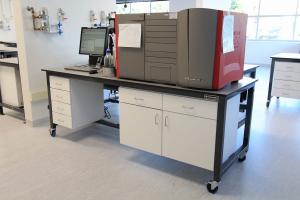The Effect of Intellectual Property Decisions on the Future of Life Science

Formaspace builds custom laboratory installations at our factory headquarters in Austin, Texas. Shown above is an installation at a research lab featuring a continuous 24-foot-long stainless steel countertop.
With new advances in artificial intelligence, see what blockbuster decisions could come next from the U.S. Patent and Trademark Office.
Yet not even two years later, the U.S. Patent and Trademark Office (USPTO) issued an 84-page decision that ruled against Doudna and Charpentier, awarding the patent for the CRISPR discovery to a group led by Dr. Feng Zhang of the Broad Institute in Cambridge, Massachusetts instead.
Coarsely speaking, you might ask, ‘what the hell happened?’
Outside USPTO observers believe that, while Doudna/Charpentier was the first to document the theoretical principles of CRISPR (a decade ago, in 2012), the Broad team was the first to demonstrate (in the eyes of USPTO patent inspectors) the successful practical application of CRISPR technology in the lab.
The decision will be appealed according to Doudna, and we’ll likely not know the final result for many years – which, according to the Wall Street Journal, is giving biotech companies using CRISPR technology fits, leading many of them to hedge their bets and enter into expensive license agreements with both parties.
As you are likely aware, patent law is enshrined in the U.S. Constitution (Article I Section 8) which gives Congress the power “to promote the progress of science and useful arts, by securing for limited times to authors and inventors the exclusive right to their respective writings and discoveries.”
Over the past 234 years since the Constitution was ratified, there have been some especially acrimonious, knock-down, drag-out fights over patent rights.
Does this sound familiar?
In one especially egregious case, an attorney locked up the rights to an invention that was critical to the development of a new industrial sector for nearly 33 years by manipulating the application process (through a series of lengthy amendments to his application).
Making the matter worse, this patent holder never built a production version of his patent, yet he (and a successor holding company) was able to collect royalties from nearly every leading company in the industry – except for four stubborn holdouts who refused to pay.
Any guesses which case this is?
The answer is the Selden patent – issued to George B. Seldon for his claim to be the invention of the automobile.
The Selden patent was famously reversed near the end of its 17-year life thanks to a lawsuit appeal brought by none other than Henry Ford and his Ford Motor Company, maker of the Model T car – on the basis that Ford and other car makers used a different, unrelated engine technology based on the principles of the Otto engine (and not the Brayton engine outline in Selden’s original patent).
Congress has revised patent law significantly over the last 232 years, including the following legislation that established and subsequently revised Title 35 of the US Code (particularly Section 101 “Inventions Patentable” and Section 102 “Conditions for Patentability”):
- Patent Act of 1790
- Patent Act of 1836
- Patent Act of 1922
- Patent Act of 1952
- Patent and Trademark Law Amendments Act (Bayh–Dole Act) of 1980
- Drug Price Competition and Patent Term Restoration Act (Hatch-Waxman Act) of 1984
- American Inventors Protection Act (AIPA) of 1999
- Intellectual Property and High Technology Technical Amendments Act of 2002
- Leahy–Smith America Invents Act (AIA) of 2011
(The latest major revision, the America Invents Act of 2011, brought about one of the biggest changes to date, switching American patent law away from “first to discover” to the more common “first to file” principle, which has long applied in most foreign countries.)
While the CRISPR patent dispute seems to center around whether Doudna/Charpentier were successful in creating a working implementation of their idea before the Broad team, many patent disputes center around whether the patent can be issued at all under the guidelines of U.S. Code Title 35, Section 101.
If you want to know the details, the USPTO offers a useful ‘refresher’ course here, but, in a nutshell, patent inspectors zero in on whether a patent application satisfies the following guidelines:
- The invention is “unobvious,” e.g., is a truly new discovery, invention, or unique synthesis of concepts not seen before.
- Provides a useful function, either as a “process, machine, manufacture, or composition of matter.”
- Does rely exclusively on “laws of nature, natural phenomena, and abstract ideas.”
Clearly, technology has changed significantly over the last 200-plus years.
As a result, USPTO patent inspectors, Congress, and the Federal courts have had to step in repeatedly to determine how current patent law applies to new technologies and circumstances.
This process of interpreting the rules has been especially consequential for those working in biotech and the life sciences.
To get a thorough appreciation of how patent law has impacted the biotech/life sciences industry over the years, let’s step through the chronology of key milestones affecting the industry by calling out the major judicial rulings that interpreted patent law as well as important legislative revisions passed by Congress.
In the field of botany and agriculture, Congress passed two major acts that allowed certain plant varieties to get 15-year patents:
- Plant Patent Act of 1930
- 1970 Plant Variety Protection Act (PVPA) of 1970
(To be exact, these acts provided for patenting asexually propagated plants but excluded sexually-propagated or tuber-propagated plants).
The 1970 revision added the provision that farmers could collect seeds from the (patented) crops they planted without infringing the patent.
This practice was challenged in the case Asgrow Seed Co. v. Winterboer, which accused the Winterboer family of growing patented plants from Asgrow Seed Co. for the express purpose of reselling the seeds to other farmers, bypassing the patent.
The Supreme Court ruled in 1994 that, under the PVPA, Winterboer could only collect enough seeds sufficient to sow new crops on their own fields and that anything beyond that was a violation of the seed patent.
But this practice was upended again by the courts in 2013 in the case Bowman v. Monsanto.
Here the Supreme court ruled that neither Bowman (nor other farmers) could collect the seeds from crops grown using Monsanto-patented seeds – unless they paid the patent royalty again.
So why did the courts give such seemingly conflicting rulings between Asgrow Seed Co. v. Winterboer and Bowman v. Monsanto?
To explain this, we have to step back to 1971 when a researcher working at General Electric, Ananda Mohan Chakrabarty, developed a new, genetically modified organism – in this case, a type of “oil-eating” bacteria that was capable of breaking down hydrocarbons – making it potentially very useful for mitigating oil spills.
Patent inspectors at the USPTO initially rejected the application on the basis that living organisms couldn’t be patented. However, after sustained litigation, the Supreme Court ruled in 1980 in Diamond v. Chakrabarty that under the Patent Act of 1952, a man-made micro-organism qualifies as a patentable idea (falling under the “manufacture” or “composition of matter” categories of Section 101 of U.S. Code 45) and that the fact the invention was alive was irrelevant.
This landmark Diamond v. Chakrabarty decision by the Supreme Court launched today’s modern biotech industry by giving inventors patent protection for genetically modified organisms.
Thus, when the Supreme Court ruled years later in favor of Monsanto (in the case Bowman v. Monsanto), they relied on the Diamond v. Chakrabarty case to decide that farmers could not propagate Monsanto’s seeds for free due to the fact they had patent protection (as genetically-modified organisms) apart from the patent rules Congress had authorized under the PVPA.
But what are the limits of patenting living organisms?
Read more...
Julia Solodovnikova
Formaspace
+1 800-251-1505
email us here
Visit us on social media:
Facebook
Twitter
LinkedIn
Legal Disclaimer:
EIN Presswire provides this news content "as is" without warranty of any kind. We do not accept any responsibility or liability for the accuracy, content, images, videos, licenses, completeness, legality, or reliability of the information contained in this article. If you have any complaints or copyright issues related to this article, kindly contact the author above.


